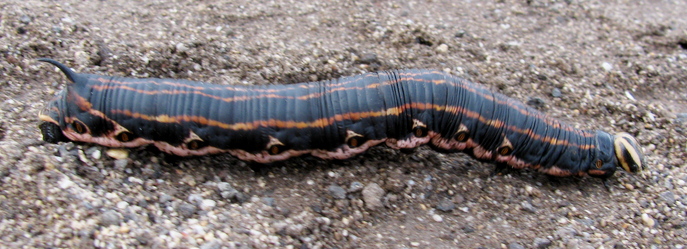Polk County’s Most Wanted – Pink-spotted Hawkmoth
Have you seen Pink-spotted Hawkmoth (Agrius cingulata)?

Conserving Carolina and botanist/ecologist David Campbell need your help in locating this month’s “Polk County’s Most Wanted—Animal,” the Pink-spotted Hawkmoth (Agrius cingulata), also known as the Sweetpotato Hornworm. Polk County’s Most Wanted is a community science initiative with a new challenge each month, in which you can expand the scientific understanding of the flora and fauna of Polk County.
Where should I look for Pink-spotted Hawkmoth?
Adult Pink-spotted Hawkmoths can be seen June-October. Adults feed on nectar from deep-throated, tubular flowers. Look for adults in open habitats including fields, meadows, weedy areas, marshes, and roadsides, as well as near lights at night.
The caterpillars can be seen in late summer and fall. They feed on morning glory, jimsonweed, pawpaw, petunia, bindweeds, and sweet potato.
How do I identify Pink-spotted Hawkmoth?
Pink-spotted Hawkmoths has a stout body and the grayish brown abdomen, with pink bands, tapers to a point. The wings are mottled gray and brown, but the hindwing has black bands and pink at the base, near the abdomen. The wingspan is about 4-5 inches, and they are strong fliers.
Caterpillars are large and stout, and they have a distinctive white and black stripped head and a horn at the end of the abdomen.

What can you do?
If you think that you have seen a Pink-spotted Hawkmoth in the adult or larval stage in Polk County, please contact Pam Torlina at [email protected] and, if possible, provide a clear image for evaluation.
For More Information
Visit Conserving Carolina’s website, conservingcarolina.org/polk-most-wanted, for more information about “Polk County’s Most Wanted” and to download and print a “Pocket Guide” with all of the “Most Wanted” plants, animals, and habitats that you can be on the lookout for!
Also, a culmination of David Campbell’s seven years in the field documenting the rare and significant flora and fauna in Polk County have been compiled in a book titled, “An Inventory of the Significant Natural Areas of Polk County, North Carolina.” The document can be downloaded for free on Conserving Carolina’s website at conservingcarolina.org/polk-county-inventory, or a hard copy can be purchased, at cost, on Amazon.
Conserving Carolina, your local land trust, is dedicated to protecting land and water, promoting good stewardship, and creating opportunities for people to enjoy nature. Learn more and become a member at conservingcarolina.org.